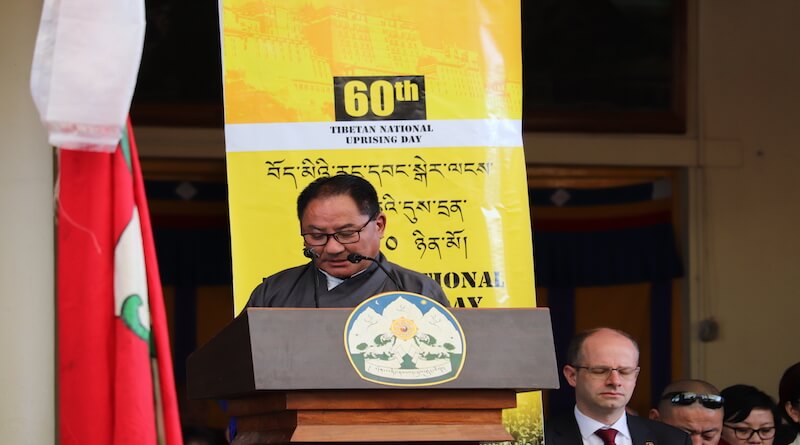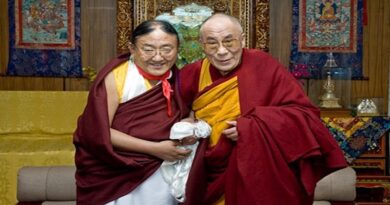Statement of the Tibetan Parliament-in-Exile on the 60th Anniversary of the Tibetan National Uprising Day

March 10, 2019
Today is a day of great importance, marking the 60th anniversary of the Tibetan people’s peaceful uprising against the Chinese occupation authorities in our homeland.
To begin with, the Communist Party of China newly established the People’s Republic of China on the 1st of October in 1949. Soon after that, the Chinese occupying army intruded into Tibet, claiming to have come to liberate it. And so began what turned out to be China’s occupation and annexation of the entire territory of Tibet. For a period of more than nine years since then, the government of Tibet at that time and His Holiness the 14th Dalai Lama embarked on a series of efforts with the aim to reach a negotiated settlement with the communist Chinese government. However, without any consultation with or consent from His Holiness the Dalai Lama and the government of Tibet, the communist Chinese government compelled under duress a delegation sent by the Tibetan government, led by Ngapo Ngawang Jigme, to sign on the 23rd of May in 1951 a document referred to as the 17-Point Agreement. This was a grossly unfair, totally one-sided document which only took into account the demands and interests of the communist government of China. Because of it, the delegation from the government of Tibet made continued efforts to reengage in discussions with the government of China. However nothing came of it. Worse, the Chinese government exerted pressure on the government of Tibet, demanding that it issue a proclamation to express its acceptance of the so-called 17-Point Agreement. Eventually, however, the negotiating team from the government of Tibet was left with no other option but to issue proclamations concerning the so-called 17-Point Agreement over the period of 24th to 26th September in 1951. In Lhasa, the Tibetan government suggested that the communist Chinese government accept three conditions if it was to endorse the so-called 17-Point Agreement. The government of Tibet at Lhasa proposed that it will accept the agreement if the communist Chinese government accepted these conditions. To this the Chinese government representative responded that the question of uniting Tibetan areas should be decided after conducting a referendum among the Tibetans in the provinces of Sichuan, Gansu, Yunnan and Qinghai. Following this development, a force of more than twenty-thousand troops of the Chinese People’s Liberation Army marched into Central Tibet. This eventually led to the falling of the entire territory of Tibet under the control of the Chinese People’s Liberation Army, leaving absolutely no avenue for the Tibetan side to hold any sort of negotiation with the Chinese Communist Government. Left with no other option and concerned very much to prevent the Tibetan people from being subjected to any sort of bloodshed while hoping to make the most of the provisions that were suggestive of being beneficial to the Tibetan side, His Holiness the Dalai Lama felt constrained to offer his acceptance of the so-called 17-Point Agreement. Meanwhile the number of troops of the Chinese People’s Liberation Army streaming into Tibet kept on increasing. In order to feed the troops of the occupying army, the Chinese authorities forced the Tibetan people to hand in their stocks of food grains to meet the large quantities it needed. As a result, prices of food grains increased ten-fold amid other kinds of food crises as well. The developments rendered the living conditions of the Tibetan people extremely precarious. All these developments contributed to an ever increasing resentment among the Tibetan people who gave vent to their pent up feeling of anger with a rising crescendo of defiance and protest. The communist Chinese government responded with more controls and repression and, in fact, began to target not only the Tibetan government itself but also the personal safety of His Holiness the Dalai Lama. With regard to the Tibetan people living in Amdo and Kham provinces, the living conditions had already been seriously affected as a result of various types of changes in the name of reform introduced by the occupying communist Chinese government. Many centres of Tibetan culture were destroyed. These led to a series of conflicts between the Chinese and Tibetan peoples, resulting in large numbers of Tibetan people being killed or executed while many others disappeared after they were taken away and put in jail. The rising strength of the reverberation of the Tibetan protests in those two provinces gradually spread to Central Tibet and finally it culminated into a massive outbreak of the national Tibetan uprising against the communist Chinese occupation on the 10th March 1959 in Lhasa the capital city of Tibet. The Chinese responded with such unimaginable brutality and violence in their repression that it led to large numbers of Tibetan compatriots being killed, injured, taken to prisons, subjected to severe beating, and so on in a situation which resembled to them the inescapable agony of suffering hell on earth. And it has been 60 years since that tragic event took place. To all the heroic Tibetan men and women of patriotism of that time, as well as to all those like them who have sacrificed their life for the sake of the Tibetan nation and people in the years after that thus far, the entirety of the Tibetan people in Tibet and in exile offer their commemoration on this day, as well as solidarity with and condolences to all the fellow-Tibetan people who even now continue to suffer repression and torture under China’s brutal policies of repression.
Over the past 60 years following the 1959 Tibetan national uprising, the adherents of the communist Chinese ideology took violent occupation control of the entire territory of Tibet and killed or directly caused the death of millions of Tibetan people in untimely, unnatural termination of their lives. With an aim to destroy the whole of Tibetan nationhood and its natural and human resources, the government of China initially launched a so-called democratic reform campaign in 1956. This was followed by the start of the Cultural Revolution in 1966. It later launched an economic opening up policy which lasted from 1979 to 1985. The Chinese government eventually incorporated Tibet in its economic Five-Year Plan Period system from the seventh plan period of 1986-1991. Under campaigns and policies of various types such as these, China carried out the destruction of a large number of Tibetan monastic and other kinds of religious sites. It set the Tibetan people against each other, making them to struggle against and kill each other. From 1968 to 1973, Tibet was hit by a severe famine, the like of which had never happened in the entire history of the nation. The government of China left more than three hundred and forty thousand Tibetan people to starve to death. It subjected the natural environment of Tibet to such destruction and plunder as to defy any concern for valuing their preservation. All sorts of coercive transformative changes were introduced which were entirely incompatible with the ground situation. Millions of Chinese immigrants are being encouraged to move into Tibet in efforts directed at making Tibet a colony of the communist ruled China. To put it succinctly, under its brutal occupation rule, China has embarked on various types of vicious policies designed to obliterate the Tibetan identity of the roof of the world through efforts to Sinicize it thoroughly. In order to accomplish and speed up this grand scheme, the leadership of the government of China has kept on worsening the effectiveness and brutality of its policies in Tibet day by day, thereby rendering the situation ever more unbearable to our brethren living in the territory. As a result, the Tibetan people in all the three traditional provinces have carried out a series of upsurges of protests against the devious policies of the Chinese government, with only courage and determination as their weapon and without being daunted by any sort of fear. Buoyed by a spirit of oath-bound integral unity for the sake of Tibet’s precious religious traditions and culture, language and so on, and driven by a design to revive and restore those aspects that have seen a decline and to promote and carry forward those aspects that have endured unblemished, the Tibetan people in Tibet have continued to carry on their movement.
It was in this milieu that in 1987 the Tibetan people staged a large-scale demonstration with shouting of slogans in their capital Lhasa. The government of China responded with extreme use of brutal force. Many Tibetans were arrested and the security measures were greatly tightened. Besides, martial law was imposed on Tibet’s capital Lhasa in March 1989. Likewise, in 2008, Tibetans in more than ninety counties across the three traditional provinces of Tibet, encompassing the Tibetan Plateau, carried out a large-scale campaign of protests against the repressive occupation rule of the communist Chinese government. At that time again, the government of China launched a violent crackdown, killing many Tibetan people, leaving large numbers of other Tibetans injured. Many Tibetan people were punished with exemplary monetary fines while large numbers of others were put in jail. Since that time, the leaders of the communist Chinese government have continued to not only totally ignore the interests and concerns of the Tibetan people but have also shown utter contempt for them. Because of it, the Tibetan people’s protest took a new turn in 2009. Since then, a total of 153 heroic Tibetan men and women have been driven by their patriotic fervour to immolate themselves in peaceful protests against the communist Chinese government. Among them a total of 22 have either survived with serious injuries or remained disappeared while the remaining 131 succumbed to their fiery protests, which is a matter of great sadness to all of us. The essence of the matter is that since China carried out its armed invasion and occupation of Tibet more than 60 years ago, the Tibetan people in Tibet have remained deprived of their basic rights to freedom of movement and residence and to act as they like in their interest. Rather, they have continued to remain under violent repression of limitless brutality.
With regard to the situation in exile over the past 60 years, His Holiness the Dalai Lama has been preoccupied with great concern for the current and enduring long-term wellbeing of Tibet and its natural resources and inhabitants since setting foot on Indian soil on the 31st of March in 1959. In order to find a solution to this multitude of problems, His Holiness has confronted the policy of brutal violence of the communist Chinese government with the peacefulness of the nonviolent approach. He set out to revive and restore those aspects of the Tibetan culture which had suffered decline and to preserve and promote those aspects that had continued to thrive. And He strove to protect the identity of the Tibetans as a people. For all these purposes, His Holiness the Dalai Lama newly set up a democratic Central Tibetan Administration which incorporated all the three pillars of democracy. Along with it, His Holiness established Tibetan refugee settlements, monastic institutions, and learning centres that imparted education in modern knowledge and Tibetan culture. In these ways His Holiness engaged in undertakings that have been of enormous service to the Tibetan nationhood and culture. As a result of these endeavours, great many educated Tibetan youngsters could be nurtured in the exile set up which has a great significance in the efforts towards realizing the just cause of the Tibetan nation and in the preservation of the ethnic identity of the Tibetan people.
From about the year 1974, His Holiness the Dalai Lama has entertained a desire to resolve the Sino-Tibetan problem through a negotiated settlement. And in 1979 China’s top leader Deng Xiaoping put forward the point that anything except independence could be discussed about and resolved; and he said that the door to negotiation was being kept open. Accordingly, without any reference to Tibet’s past status and situation, with a view to find a solution to the urgent immediate problems affecting Tibet, and with the hope for the development of a state of peaceful coexistence between Tibet and china for the enduring future, His Holiness adopted an exceedingly open-minded approach. He explored all possible avenues and means to find a solution to the Sino-Tibetan dispute on the basis of a mutually beneficial middle way approach by holding direct talks with the Chinese government. However, the government of China then sought to turn the issue of Tibet into that of the personal status of His Holiness the Dalai Lama. On other hand, it refuses to accept that there is any problem concerning the situation in Tibet as a whole that bears discussing. And so, in that way, the government of China tried to keep whiling away time. It was then that in 1987, in order to realize a dialogue with China, His Holiness the Dalai Lama presented a Five-Point Peace Plan for Tibet that was mutually beneficial to both the sides in an address before the Human Rights Caucus of the United States Congress. Later in 1988, His Holiness elaborated on that plan in an address to the European Parliament in the French city of Strasbourg. The mutually beneficial middle way policy was on the 18th of September in 1997 unanimously adopted by the Tibetan Parliament in Exile. And in an effort to ensure its effective implementation, nine rounds of talk and one informal consultation were held between envoys of His Holiness the Dalai Lama and representatives of the government of China over a period which extended from 2002 to 2010. The talks could not be continued after 2010 due to lack of interest from the side of the government of China. Nevertheless, His Holiness the Dalai Lama and the Central Tibetan Administration continue to remain in a state of preparedness to hold talks with representatives of the government of China any time the latter is ready. Besides, the best possible way to resolve the issue of Tibet is to hold talks. We therefore call on the government of China to be appreciative of this reality and accordingly make renewed efforts to create the right environment for holding talks.
Many governments, parliaments, governmental and non-governmental bodies, and Tibet support groups as well as international organizations and private individuals, including those in the United States of America, Europe, and India, have extended support for the just cause of the Tibetan people and praised our struggle for freedom by the method of nonviolence. Besides, Chinese intellectuals and democracy activists living overseas, as well as many educated Chinese with unbiased perspective have expressed admiration and praise as well as extended support for the position adopted by the Tibetan people. In related developments, United Nations Organization bodies as well as parliaments of many countries have been able to adopt a substantial number of resolutions related to the issue of Tibet. With the aim to enable the facilitation of investigation of the ever worsening critical situation in Tibet, the United States Senate passed on the 11th of December in 2018, a bill titled The Reciprocal Access to Tibet Act. This was followed, on the 19th of December in 2018, by the President of the United States of America signing the bill so that it formally became the law of the land. We remain hopeful that as a result of this new law, people in the outside world will be able to gain a clear understanding of the situation in Tibet and there will be improvement in the situation of the Tibetan people in Tibet.
Over the past 60 years, the communist Chinese government has continued to adopt various types of vicious means and methods in efforts directed at obliterating the nationhood of Tibet and its natural resources and inhabitants to the extent of aiming to render them non-existent on the global atlas. However, the entire Tibetan people both in Tibet and in exile have made concerted, unrelenting efforts during that period to continue their struggle for freedom and to preserve their ethnic identity, language, culture, and moral principles. As a result, the Tibetan nationhood, religious traditions, political institutions, and ethnicity continue to thrive at this time. They can be recognized as an achievement of the Tibetan people for their new generation after these 60 years. We owe this mainly to the selfless efforts made at great personal sacrifices by His Holiness the Dalai Lama as well as the older generations of Tibetan people. We accordingly take the opportunity provided by this occasion to offer to them our heartfelt prayers of gratitude of great immensity.
Language is the soul of a people. Peace and nonviolence is the sole method for the realization of the just cause of the Tibetan people. Hence it is incumbent on us to keep in heart whatever advices His Holiness the Dalai Lama has routinely been providing us in terms of preserving our ethnic identity, language, culture and so on. With this perspective in view, we should strive to carry forward those aspects of our culture, language and so on which continue to thrive and work to revive and restore those aspects of them which are seen to have suffered a decline. For this purpose the concerned people in the Central Tibetan Administration, monastic institutions, schools, governmental and non-governmental organizations and welfare groups, and the settlements should make concerted efforts. Along with it, the monks and nuns, students, and the public residing in the settlements should all shoulder their enjoined responsibilities without any let down or shortcoming for as long as it takes without any loss of hope and determination until the just cause of the Tibetan people prevails. We accordingly appeal that this be continued to be carried out in a sustained manner.
Likewise, apart from the government and people of India, there have been political leaders, legislative bodies, organizations and groups, intellectuals, media professionals, general publics, students, and ethnic Chinese people who have continued to extend unequivocal support for the issue of Tibet. To all of them we take this opportunity to offer our gratitude.
Finally, we pray that His Holiness the Dalai Lama may live for a hundred aeons and see all his wishes fulfilled with spontaneity, with the just cause of Tibet being seen realized in all speediness.
Tibetan Parliament-in-Exile
10 March 2019
(Tibet.net)






